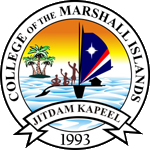College of the Marshall Islands
This article needs additional citations for verification. (February 2018) |
 | |
| Type | Community college |
|---|---|
| Established | 1993 |
| Location | , Majuro Atoll , |
| Website | www |
The College of the Marshall Islands (CMI) is a regionally accredited autonomous community college offering associate degree programs in liberal arts and sciences, business and information technology, elementary education, and nursing. It also offers high school equivalency, community extension, student development, and certificate programs. The College primarily serves students from within the Micronesian region and is designated as the national post-secondary institution for the Republic of the Marshall Islands (RMI), as enacted in RMI PL 1992-13, The College of the Marshall Islands Act.
Accreditation status[]
The College of the Marshall Islands is accredited by the Accrediting Commission for Community and Junior Colleges (ACCJC) of the Western Association of Schools and Colleges (WASC).
The ACCJC accredits associate degree granting institutions in California, Hawaii, the Territories of Guam and American Samoa, the Commonwealth of the Northern Mariana Islands, the Republic of Palau, the Federated States of Micronesia, and the Republic of the Marshall Islands. ACCJC is one of three commissions under the regional accrediting entity known as WASC.
In January 2009 the ACCJC reaffirmed CMI's accreditation for a six-year term pending a self study review the spring of 2009.
History[]
The main campus of the College of the Marshall Islands is located in Uliga, Majuro Atoll. The College Administration Offices and the Library are located in the buildings formerly used as a hospital, as are some classrooms. The two-story Classroom Building, completed in 1991, has a 1996 four-classroom addition. The building also contains the Business Computer Lab, the College Achievement Project Learning Lab, and the Student Center, for study and quiet relaxation. Adjacent buildings house Land Grant Cooperative Research and Extension programs and PEACESAT administration, Upward Bound and College Achievement Project (SSSP).
Academic year 1999-2000 was a period of major campus growth and development. The two-story Science Complex, completed in mid-2000, added three large new classrooms, a small Science Computer Lab, and science research rooms that include an Agricultural Grow Room. The Administration Annex, just beyond the men's and women's dormitories, includes the Maintenance Office and facilities, Personnel and the Personnel Conference Room.
Oscar deBrum Hall, redeveloped and given that name in late 1999, houses the Continuing Education program on the first floor and faculty offices on the second. The College grounds were also much increased during this period by the replacement of a large service-road area with grassy areas and pathways that center on the College flagpole.
The community college now known as the College of the Marshall Islands (CMI) came into existence officially when the Board of Regents of the Community College of Micronesia (CCM) issued its charter on October 10, 1989, designating it as the College of Micronesia-Majuro . Two years later, in January 1991, it was given its present name and accredited by the Accrediting Commission for Community and Junior Colleges. In April 1993, CMI became an independent entity with its own Board of Regents and was chartered to serve as the post-secondary agency for RMI.
CMI, as an institution, can trace its origins to several earlier programs; of these, the oldest was a school of nursing established by the Trust Territory of the Pacific Islands . Begun on Moen Island in Chuuk (1953), it was later moved to Pohnpei, to Palau, to Saipan in the Northern Marianas, and finally, in 1986, to Majuro. This School of Nursing was affiliated in 1972 with the University of Guam, to confer the Associate of Science degree in Nursing. Two jurisdictional changes occurred later: in 1975, the Trust Territory Department of Public Health assigned responsibility for the school to the Community College of Micronesia (CCM) under the Trust Territory Department of Education; and, in 1978, to the newly created College of Micronesia's (COM) first Board of Regents.
The origins of education courses at CMI can be traced to the Micronesia Teacher Education Center (MTEC), opened in 1963 on Pohnpei for in-service instruction. It soon established a branch on Majuro, known as Marshalls ’ Teacher Education Center (MARTEC). In 1970, the High Commissioner of the Trust Territory issued a directive making the education centers into the Community College of Micronesia (CCM); thus, Majuro's program became an extension of CCM, offering pre-service elementary teacher education. Three years later, in 1973, it added a Curriculum, Learning and Training Center (CLT) which awarded graduates a two-year degree in education. The dual focus of CLT was on teacher education and curriculum development; this latter covered most elementary subjects and was tested in Majuro's Rita Elementary School . In 1990, the program, now called the Continuing Education Center, ceased to be an extension of CCM and it was renamed CMI Division of Instructional Services.
Another component of the present institution dates from 1981, when CCM, based in Pohnpei, was awarded U.S. Land Grant status. It began operations on Majuro in 1983, offering non-credit courses in agriculture and home economics, among others, and it continues to do so. By 1987, all three programs—nursing, education, and Land Grant extension—were housed together in Majuro on the present campus; in 1988, they were integrated under a single administrator by directive of the COM Board of Regents. In 1989, they were combined to constitute the College of Micronesia-Majuro which became independent in April 1993 as the College of the Marshall Islands (CMI).
References[]
External links[]
- Education in the Marshall Islands
- Colleges in the Marshall Islands
- Schools accredited by the Western Association of Schools and Colleges
- 1993 establishments in the Marshall Islands
- Majuro